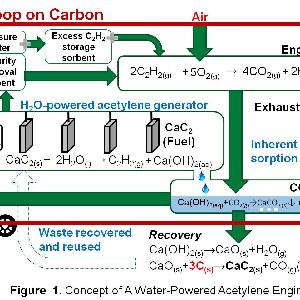
Blast from the Past: A Water-Powered Acetylene Engine by Blast from the Past
Please find below the
Finalist Evaluation
Judges'' comments
An interesting proposal for an alternative fuel. Calculations seem to neglect the weight of the water needed to be carried for the Acetylene production and for the capture.
If the weight considerations work out, the single biggest drawback is the production of CaC2 from coal. Unless an alternative source can be worked out (e.g . from biomass) I don't see how starting this would affect climate change.
Perhaps interesting for trucks?
Is it more reasonable to go this route than switch to an electric fleet and de-carbonise electricity generation? More needs to be said about the challenges to this innovation and how they would be overcome. This is more important for such a disruptive technology.
This is an interesting proposal. Importantly, it must be made clear why this is not a perpetual motion machine. The energy use/generation in the cycle described need to be described.
One barrier to entry not described is the required infrastructure changes. This would probably be significant and would reduce the speed at which the technology could be adopted, and would increase ultimate costs.
Semi-Finalist Evaluation
Judges'' ratings
| • | Novelty: | |
| • | Feasibility: | |
| • | Impact: | |
| • | Presentation: |
Judges'' comments
Thank you for your submission to the Climate CoLab. The Judges were impressed with your proposal thus far, and felt it was well-articulated. They suggest shortening the introduction, and better addressing the scalability of the approach.
They would recommend giving ranges for how much carbon you expect to be able to capture instead of only stating the maximum. Under Section III you mention that 'most of the CO2 was captured' - it would be better to give a percentage.
Also, have you confirmed that you would actually be able to generate enough energy to drive a car? How big would the engine need to be to do this, and what would it weigh?
 James Moo Jun 14, 2016 11:43 | Proposal creator We thank the reviewers for their comments and have revamped our proposal in accordance to the suggestions. Below, we have attached a summary of the changes.
We have shortened our introduction to our action plan in the summary. The scalability of the action plan is illustrated in a sample city of Paris (France). This includes a demonstration of an ecosystem to establish the use of calcium carbide as the fuel source of the future in “Where will these actions be taken?” This was immaculately detailed in a calcium carbide grid that is linked to renewable energy sources in the schematics.
Under Section III, we have included a reference of the percentage of the CO2 that can be captured on site at the factories and also a gauge of the amount of carbon dioxide that is captured in vehicles in a single tiered system, where a development of a multi-tiered system is envisaged to almost completely remove the CO2.
We demonstrated with the aid of a figure that the energy generated by calcium carbide per unit volume is greater than gasoline, giving 50% more mileage than the common gasoline engine. This is illustrated in “What actions do you propose? IV Functional Advantage in Energy Efficiency Comparison”.
We are targeting a retrofit of the fuel tank in the engine. The fuel tank as such can remain in the same configuration of a common sedan car, maintaining at a volume of 40 L. It will not weigh significantly different from the present engines, with the change increasing the weight by 58 kg. This is illustrated in “What actions do you propose? IV Functional Advantage in Energy-to-weight ratio in gasoline and CaC2 engines”. |